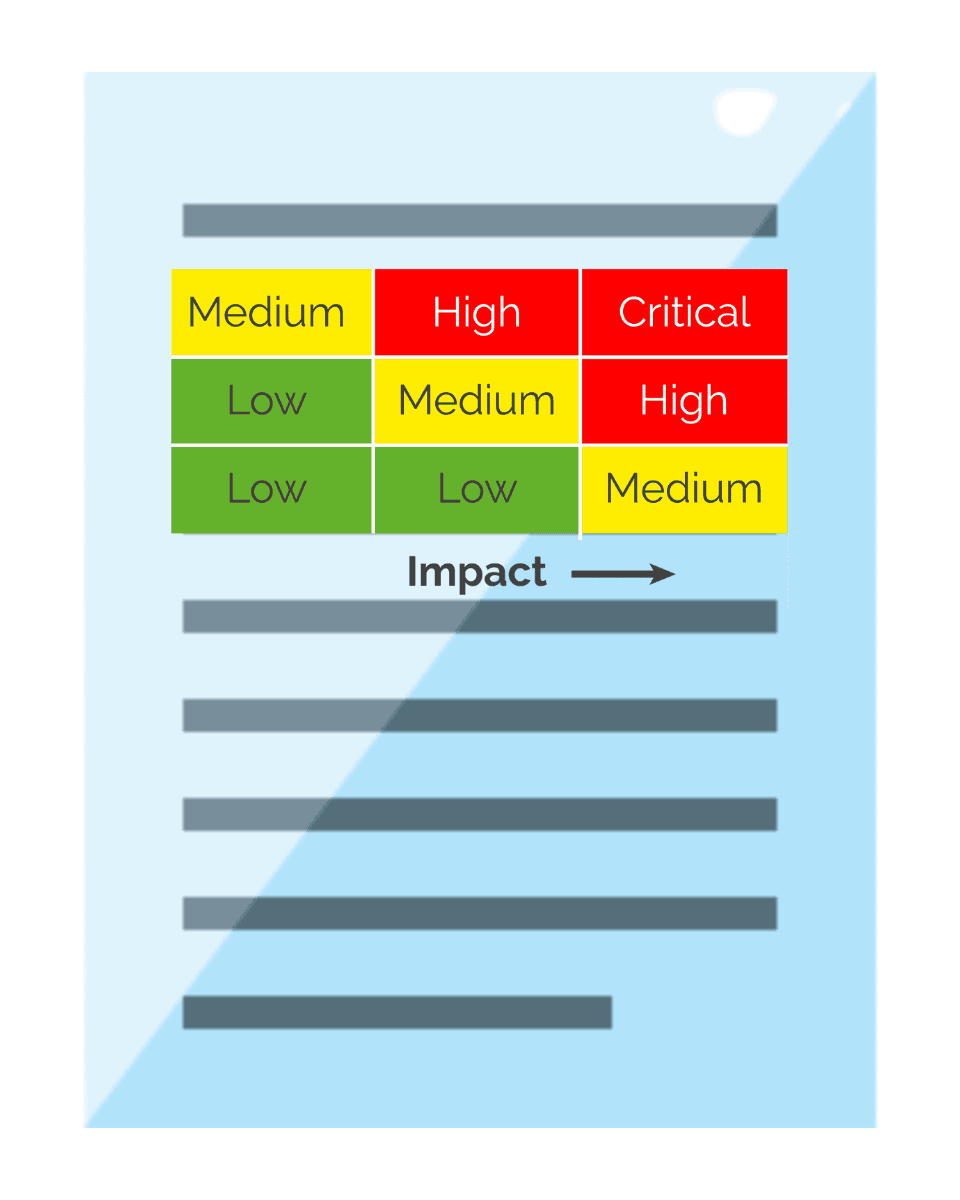What Is Visibility In Vulnerability Management?
Vulnerability visibility is the process of having insight into an organization’s assets and potential risks, allowing for security improvements.
This involves having the ability to detect any potential issues before they cause harm, as well as implementing continuous monitoring to catch any new threats that may arise.
Free Security Policy Templates
Get a step ahead of your cybersecurity goals with our comprehensive templates.

Why Gaining Visibility Can Be Difficult
While security teams might have a good understanding of their internal network environment, there are areas where it’s more difficult to gain visibility.
Some examples include:
- External networks: Gaining visibility into external-facing applications can be challenging for security teams, as these applications might be hosted on different platforms or be managed by different teams.
- Containers: The relatively new technology of containerization can create visibility challenges for security teams who are still learning how to implement scanning and monitoring for these environments.
- DNS management: Managing DNS records for various applications and websites can be complicated, as these records may change or become outdated when applications are decommissioned.
The Importance Of Visibility In Cybersecurity
The adage goes, “you can’t secure what you don’t know.”
The level of visibility an organization has in its IT environment has a direct impact on its overall security posture.
Poor visibility can result in unidentified assets and undetected vulnerabilities, leaving the organization exposed to potential attacks.
Here are some specific examples of why visibility is so important:
- Identification of assets: Visibility lets security teams build an inventory of all the assets within their company. This record acts as the base for assessing and prioritizing vulnerabilities.
- Detection of vulnerabilities: Comprehensive visibility helps security teams detect vulnerabilities more accurately, allowing timely remediation and decreasing the possibility of potential attacks.
- Monitoring and tracking: Visibility makes possible ongoing monitoring and tracking of assets and vulnerabilities. Doing so helps organizations stay aware of novel threats and guarantee the efficiency of their vulnerability management initiatives.
The Impact Of Poor Visibility On Security
Poor visibility in vulnerability management can lead to increased risk for organizations, as security teams struggle to gain a complete understanding of their environment and the potential vulnerabilities present.
This lack of understanding can result in:
- Incomplete remediation: Without proper knowledge of existing vulnerabilities or assets within the organization, it can be difficult for them to apply effective mitigation strategies and put appropriate measures into place.
- Acceptance of risk: Organizations may choose to accept the risk associated with certain vulnerabilities due to the perceived complexity or cost of implementing a solution. This decision may leave the organization vulnerable to future attacks.
Learn More: How To Prioritize Vulnerabilities
Common Blind Spots In Vulnerability Assessments
 When conducting vulnerability assessments, there are often areas that are frequently overlooked or not managed well.
When conducting vulnerability assessments, there are often areas that are frequently overlooked or not managed well.
Identifying these blind spots is crucial for achieving comprehensive visibility into vulnerabilities.
Learn More: How To Conduct A Vulnerability Assessment
Unmanaged Assets
Unmanaged assets pose a risk because they lack corporate security controls, such as regular patching, monitoring, and access restrictions.
This absence of security measures leaves them more susceptible to exploitation, cyber attacks, and unauthorized access, potentially causing significant damage to the organization’s reputation and operations.
Unmanaged assets often become a blind spot for organizations due to rapid growth, frequent changes in personnel, or lack of clear ownership.
To address unmanaged assets, organizations should:
- Maintain an up-to-date asset inventory, including ownership information.
- Implement a clear asset management policy that assigns responsibility for each asset and outlines security requirements.
- Provide regular training to employees on asset management best practices and security protocols.
- Conduct periodic audits to identify and remediate any unmanaged assets.
Legacy Systems
Legacy systems often become a blind spot because organizations may rely on their continued operation for critical processes or be hesitant to invest in costly upgrades.
As a result, these systems may not receive necessary security updates or patches.
Unsupported legacy systems are more susceptible to cyber attacks, as vulnerabilities may go unaddressed. This can result in data breaches, operational disruptions, and reputational damage.
To tackle these risks organizations should:
- Conduct a thorough risk assessment to identify vulnerabilities in these systems.
- Prioritize the replacement or modernization of high-risk legacy systems.
- Implement strong security measures, such as network segmentation and access controls, to minimize potential damage.
- Develop a contingency plan for handling incidents related to legacy systems.
DNS Records
DNS record management can be overlooked due to the dynamic nature of organizations and their websites.
As teams come and go, DNS records may not be properly maintained, leading to outdated or orphaned records that create confusion and potential security gaps.
Unmanaged DNS records can expose organizations to security risks such as unauthorized access, data leaks, and even domain hijacking.
They can also make it harder to track down and remediate vulnerabilities, impacting the overall security posture.
To address the challenge organizations should:
- Implement a centralized and automated DNS record management system to track and maintain records.
- Establish clear policies and procedures for creating, updating, and decommissioning DNS records.
- Regularly audit DNS records to identify and rectify discrepancies or security issues.
- Foster communication between security teams and other departments to ensure accurate and up-to-date DNS records.
Techniques For Identifying & Tracking Assets
The number one piece of advice is to start small and build gradually while also knowing that creating a comprehensive asset list is a continuous process.
This means it must be regularly maintained and updated for maximum accuracy.
Begin by manually documenting known assets and their owners, even if it only covers a small percentage of your organization’s assets initially.
Over time, you can expand and refine your inventory, gradually increasing coverage.
Collaborating with other departments is also a great way to gain buy-in for security objectives while also communicating the need for each business unit to take security seriously.
Work closely with other teams within your organization, such as Finance or Marketing departments who may have similar goals.
By sharing objectives and collaborating, you can more effectively gather information and create a comprehensive asset inventory.
Ensuring Vulnerability Scans On All Endpoints
To ensure that all endpoints, including remote and BYOD devices, are included in vulnerability scans, organizations can implement the following strategies:
- Rely on IT processes: IT teams often track assets to know which devices are being used by which person. Leverage this information to include all endpoints in vulnerability scans.
- Analyze logs: SIEM logs can provide valuable information about user connections and help identify devices that need to be included in vulnerability scans.
- Use managed browsers: Managed browsers, like Google’s BeyondCorp, can provide improved control over user access to applications and websites. By requiring users to connect through these managed browsers, organizations can more easily monitor and include all devices in vulnerability scans.
When working to keep networks secure, it’s important to recognize that there is no silver bullet for covering all potential weak spots.
Network Segmentation's Role In Improving Visibility
Network segmentation’s role in improving visibility lies in its ability to compartmentalize the network, allowing organizations to monitor and manage security more effectively.
By dividing the network into smaller segments, it becomes easier to track and identify vulnerabilities specific to each segment.
Although network segmentation doesn’t directly improve visibility, it does provide a more organized and efficient environment for vulnerability detection and management.
A few benefits of network segmentation as it relates to vulnerability management include:
- Easier management
- Forced asset inventory
- Targeted vulnerability scans
- Improved incident response
- Better access control and policy enforcement
Third-Party Vendor & Supplier Inclusion In Vulnerability Assessments
Incorporating third-party vendors and suppliers into vulnerability assessments helps organizations gain a more comprehensive understanding of potential vulnerabilities.
The challenge lies in the limited visibility into these vendors’ internal practices, as companies often rely on certifications and contractual agreements, which may not accurately represent the vendors’ actual security posture.
To improve visibility into vulnerabilities, organizations should prioritize limiting the connections between themselves and their vendors.
This process involves scrutinizing the data shared between the two parties and assessing the necessity of each exchange.
By minimizing connections, organizations can better identify vulnerabilities and potential security risks that could arise from these third-party relationships.
Conducting security awareness and training is another aspect of enhancing visibility into third-party risk.
When employees understand which data can and cannot be shared with vendors, they are better equipped to identify potential security risks and handle sensitive information responsibly.
The Role Of Penetration Testing & Red Teaming In Increasing Visibility
Penetration testing and red teaming techniques help organizations gain deeper insight into vulnerabilities over automated scans and vulnerability assessments.
Pen testing focuses on analyzing specific applications or systems, uncovering vulnerabilities, and testing the effectiveness of existing security measures.
This targeted approach helps organizations identify and address potential weak points in their applications, contributing to enhanced vulnerability visibility within specific systems.
Red teaming involves a group of offensive security professionals simulating real-world cyber attacks to evaluate an organization’s overall security posture.
Red teams emulate the tactics used by actual attackers, uncovering vulnerabilities that span across multiple systems and applications.
This broader view helps organizations better understand their entire attack surface, allowing them to prioritize vulnerabilities and implement effective remediation strategies.
By collaborating with red teams, blue teams can gain valuable insights into potential attack vectors and enhance their defensive strategies.
Purple teaming is another concept that involves red teams simulating attacks and blue teams defending against them, promoting continuous improvement of detection, response, and remediation capabilities.
By utilizing pen testing, red teaming, and purple teaming, organizations can significantly improve their visibility into potential vulnerabilities.
Security Rating Platforms For SMBs
While red teaming provides a wealth of information and visibility into an organization’s security posture, it is likely out of reach for most SMBs. This is often due to cost and resource constraints.
However, SMBs can still gain the benefits of red teaming without incurring high costs by adopting security rating platforms and automation.
Security rating platforms help SMBs discover and conduct basic tests on their networks and applications.
These platforms are designed to assess an organization’s security posture, identify common vulnerabilities, and pinpoint the shortest and easiest paths that attackers might exploit.
The use of automation further enhances the security efforts of SMBs.
By automating routine tasks like vulnerability scanning and patch management, SMBs can reduce manual effort and allocate resources to more strategic initiatives.
In addition to improving security, these solutions can help SMBs sell ideas or projects to management.
By demonstrating the findings of a security rating platform or automated test, SMBs can make a stronger case for implementing security recommendations and gaining management buy-in.
How Proper Configuration Of Scanners Improve Visibility
Properly configuring your scanner ensures comprehensive coverage of assets, regular monitoring, and the generation of actionable reports, all contribute to a more effective vulnerability management process.
Configuration of scanners involves setting up appropriate scan schedules and frequencies, ensuring that your organization maintains up-to-date information on the security status of its assets.
For example, when using a scanning tool in a cloud environment, configuring the tool to access the necessary APIs ensures that all instances within your infrastructure are identified and assessed.
This setup allows the tool to provide a comprehensive view of your cloud-based assets and their respective vulnerabilities.
Learn More: Best Practices For Cloud Vulnerability Management
On-premises environments, however, can be more challenging due to the presence of routers, proxies, and firewalls.
In such cases, it’s important to segment your network effectively and set up the scanning tool to cover all IP address ranges, ensuring that no assets are left out during the scanning process.
This may require working closely with your network team to map out the entire infrastructure accurately.
Creating An Effective & Actionable Visibility Strategy
To develop an effective and actionable visibility strategy, organizations must first start by measuring their current security posture.
This involves gathering data on vulnerabilities, assets, and overall risk.
Having quantifiable cybersecurity metrics and KPIs helps to communicate potential issues to management and demonstrates the need for action.
One approach to creating a visibility strategy is to implement monitoring tools, such as cloud connectors, to track and assess assets within your organization’s environment.
However, it’s important to recognize that not all accounts or assets may be covered by these connectors.
To address this gap, organizations can establish regular review processes, such as quarterly or yearly assessments, to extract a comprehensive list of all cloud accounts and cross-check the presence of the necessary connectors.
As organizations evolve and grow you should involve team members in the visibility strategy and continuously refine the processes.
Encouraging participation from various departments and stakeholders can lead to a more comprehensive understanding of the organization’s risk landscape and help identify areas for improvement.
The visibility strategy should also include regular reviews of the organization’s assets and vulnerabilities.
This ensures that the organization is constantly aware of its risk exposure and can prioritize remediation efforts accordingly.
Regular assessments also allow for the continuous improvement of the visibility strategy, as new insights are gained and best practices are identified.
Metrics You Should Be Measuring
To gain a better understanding of an organization’s true risk, it’s important to measure specific key performance indicators (KPIs) related to visibility.
Here are a few KPIs that organizations should consider when tracking visibility:
- Coverage: This KPI indicates the percentage of assets where a security tool, such as a cloud agent or scanner, is installed and functioning. It helps organizations identify any gaps in their security monitoring and ensures comprehensive protection across all assets.
- Technology-specific metrics: Monitoring technology-specific KPIs allows organizations to focus on areas that require attention and allocate resources accordingly. This could include instances, containers, web applications, databases, and other critical components.
Practical Tips For Improved Visibility In Vulnerability Management
For vulnerability management professionals seeking better visibility into vulnerabilities and their overall attack surface, here are some practical tips to consider:
- Start Small
- Work with Individual Teams
- Make Incremental Progress
Start Small
It’s easy to get overwhelmed when taking a project head-on. Instead, break the seemingly insurmountable challenge into bite-sized tasks.
For example, focus on a specific technology like cloud instances and then progress to web applications or databases.
This tactic allows you to build a solid foundation in vulnerability management and gradually enhance visibility over time.
Work With Individual Teams
Collaborate with one team at a time to develop the processes for vulnerability management.
After the process is working well within one team, move on to other teams.
This method ensures a more efficient and effective approach to improving visibility.
By customizing the process to each team’s specific needs, cooperation between teams can be strengthened and all personnel can be informed about the vulnerability management strategy.
Make Incremental Progress
Rather than striving for a perfect solution, adopt an incremental improvement system.
Focus on making small progress every month or quarter and these improvements will accumulate over time, resulting in better visibility and risk understanding.
Regularly evaluating progress and adjusting your strategy accordingly has proven beneficial in maintaining momentum when it comes to enhancing vulnerability management processes.
Article by



